Unfortunately, from Mysore to Kochi we had to travel by coach since there was no train and that journey was quite nightmarish. The entire night the coach kept jumping up and down, not only because of the quality of the road and the holes in it, but also because of the non-existing shock absorbers. Although the seats could recline, they were covered by some plastic-like material and I kept sliding down my seat. For this reason, I spent the entire night trying to push with my feet against the floor, thus preventing the sliding, so in the morning I could hardly get out of the coach because my knees hurt me extremely badly on account of that much effort put onto them. Luckily, this passed fairly quickly.
However, even to this very day I remember quite vividly that night’s journey because of a completely unrelated thing. Parallel to us, on the seats on the other side of the passage there was, as it would turn out, a married couple – he was quite older than her and she was still very young, but also incredibly beautiful. She had darker complexion than usual, which suggested she was from the south of India. They were travelling with their small baby who often coughed, but that was not bothersome in any way. At some point the coach made a break in the journey and the husband went out. Since we were all awake, that young woman addressed us in not too good English, but it was obvious she wanted to tell us something that seemed important to her. She actually simply kept apologising, explaining that her baby did not have proper cough (I guess in order for Sneža and I not to be worried lest we contracted it from the baby), but apparently the infant had some heart problems and this was precisely why they had gone to some medical experts in Mysore to have some tests done there.
I found this extremely hard, on the one hand because this was a baby that was not even a year old and still it had to face such serious problems. However, on the other side, I found this deeply embarrassing that the mother thought she should justify herself in front of these two foreigners and apologise for the coughing of her baby. Some female instinct linked to the care for “thy neighbour” started to work inside of me and I wished I did something. The only thing that occurred to me under the given circumstances was that perhaps I could give some decent monetary donation with the hope that this could make it easier for them to buy some medicines or something similar and to say that this was a gift for the baby, but I also felt quite uncomfortable since I did not know how to do it without offending them. I figured I could try to do it when we reached Kochi, but during the night, when the coach made a stop in some place along the way, the parents with the baby in their arms suddenly got up and left.
So, following the rather uncomfortable journey and just a couple of hours of sleep, in the morning we reached Kochi. We transferred to the old part of the city that is called Fort Kochi where we had already booked a hotel. Since we arrived in the morning, our room was still not ready, so the landlord sent us for breakfast to a nearby place called Koshi Café which is practically an institution in the neighbourhood.
The breakfast was great: different fruits and two pieces of cake.
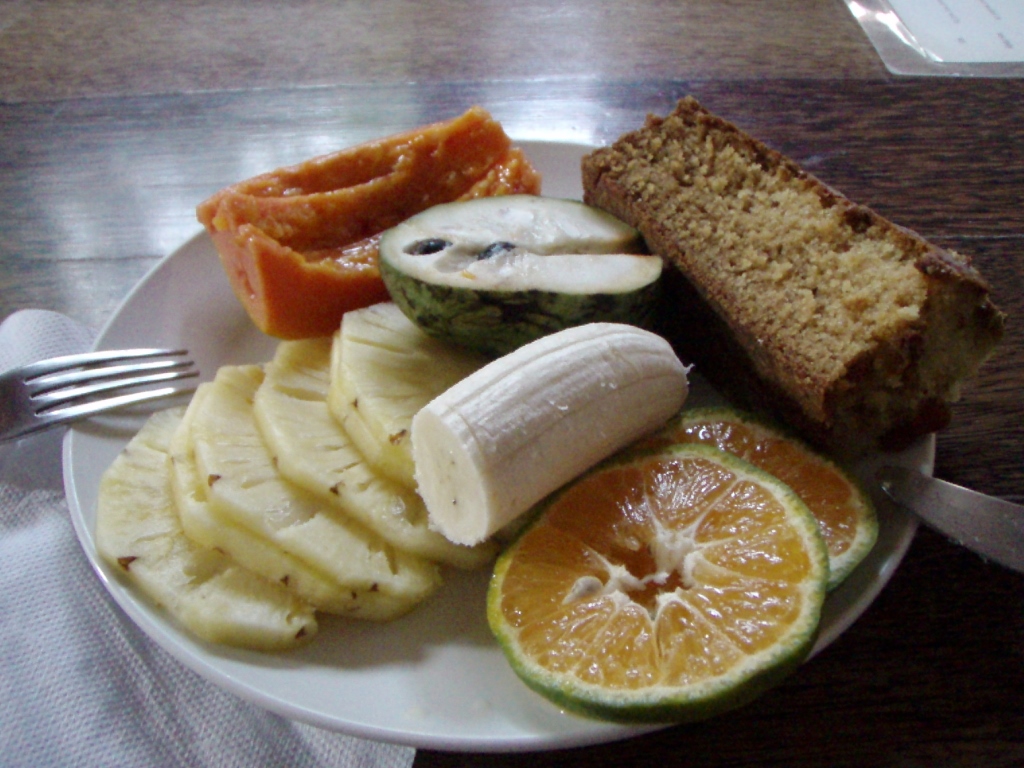 Breakfast in Kochi
Breakfast in Kochi
The cake was ok, but the fruits were great! As it can be seen, there were pineapple, papaya, banana and orange (don’t be misled by the green skin, the fruit was perfectly ripe), and there was also custard apple (Annona cherimola). The variety of the Annona genus that grows in India is called in the numerous languages spoken on the sub-continent Sitaphal, which means Sita’s fruit. Since I haven’t mentioned Hindu gods for a while, here is a fine opportunity. Sita is the consort of Lord Rama, who is an incarnation of god Vishnu and his main incarnation Krishna. Sita herself is an avatar or incarnation of Sri Lakshmi.
I truly enjoyed this breakfast, both as a feast to my eyes and the feast to my body, since I was very tired. Although we stayed at the café for some time, our room was still not ready when we returned to the hotel. We had to wait for a little while yet, but when we got into the room the primary joy came from the fact that after a couple of days we finally had shower. After this good refreshment, we both went to bed and deep sleep, although this did not last for too long.
Afterwards we got out and went for a walk a little before finding some place to have late lunch at. In Kochi we were greeted by very high air humidity, so despite the earlier shower, all the time I had the feeling of sticky skin. Anyway, when we finished with the lunch, we started inquiring about the excursions we wanted to go to, but almost nothing of what was on offer could fit into our plans, so we were in two minds as to what to do about it.
Later while we were having coffee, Sneža decided to start with detailed planning of the remaining days. Our journeys are generally based on my coming up with the route and the places we will visit, and along the way I also see how we are to move from one place to the next. Sneža usually goes along with my ideas, but if she herself starts to plan then she goes into much more detailed level of planning with all the times in minutes (she’s an engineer and loves figures). So, I listened to her for a short while and then I just started nodding, for it was clear to me that at that point in our journey we simply had too many unknown elements. India is not a destination where it is easy to plan much ahead and down to a minute.
What we could plan and also execute was the purchase of plane tickets from Chennai to Pune and there we certainly had to fix the dates and the time. The reason why we decided for a plane journey was very simple: we wanted to avoid a 30-hour train ride.
When we had finished with this it was time to have dinner. Kerala is famous for many things and among them there are different costumed shows with traditional dances. The best known among those dances is kathakali. We were thinking about going to such a show, but were still absolutely exhausted, so we gave up the idea. We just went for dinner and then retired early in order to catch up with the sleep.
The next morning we woke up certainly more rested and then we went to the same café for breakfast. We also took the opportunity to stroll around the old centre of Kochi.
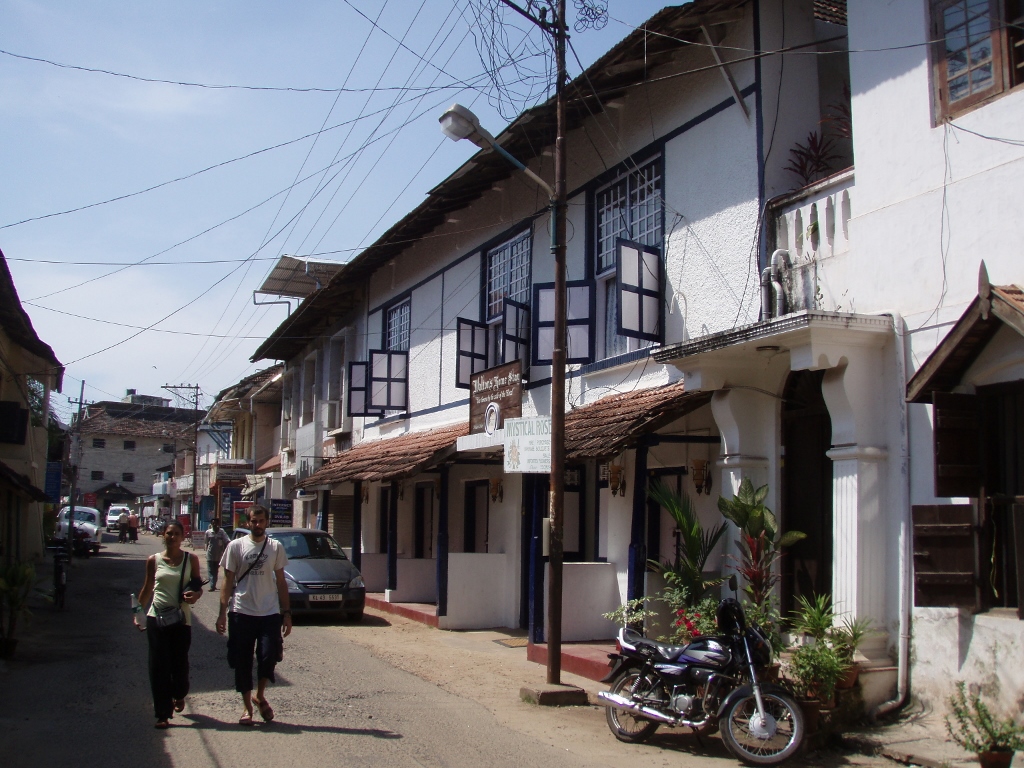 Princess Street
Princess Street
Kochi was quite different from what we had already seen in India. The reason for this lies in the fact that near this place where there is an incredibly good and tucked-in port there was a whole procession of colonisers from Western Europe, first the Portuguese, then the Dutch and finally the Brits, so all of them have left their trace.
Among other sections, Kochi nowadays includes Fort Kochi which is often called Old Kochi, as well as Ernakulam, a contemporary settlement in the back of the lagoon where we actually arrived by coach from Mysore the day before. Ernakulam is in fact located on the mainland, while the entire rest of the city spreads along narrow peninsulas and numerous islands. Practically the whole federal state of Kerala that is parallel with the shore of the Arabian Sea has a large number of brackish lagoons and lakes that are connected by canals and rivers into a huge network of waterways. The total length of those waterways is over 900 km. The entire system is called the backwaters.
However, although the name may suggest stagnant waters, with time this waterway system has developed into a very lively part of the state, so there is nothing inactive there.
To start with, we walked to the so-called Chinese Fishing Nets. These very specifically made contraptions used for fishing originate back in the 14th century when the Chinese used to come here to trade.
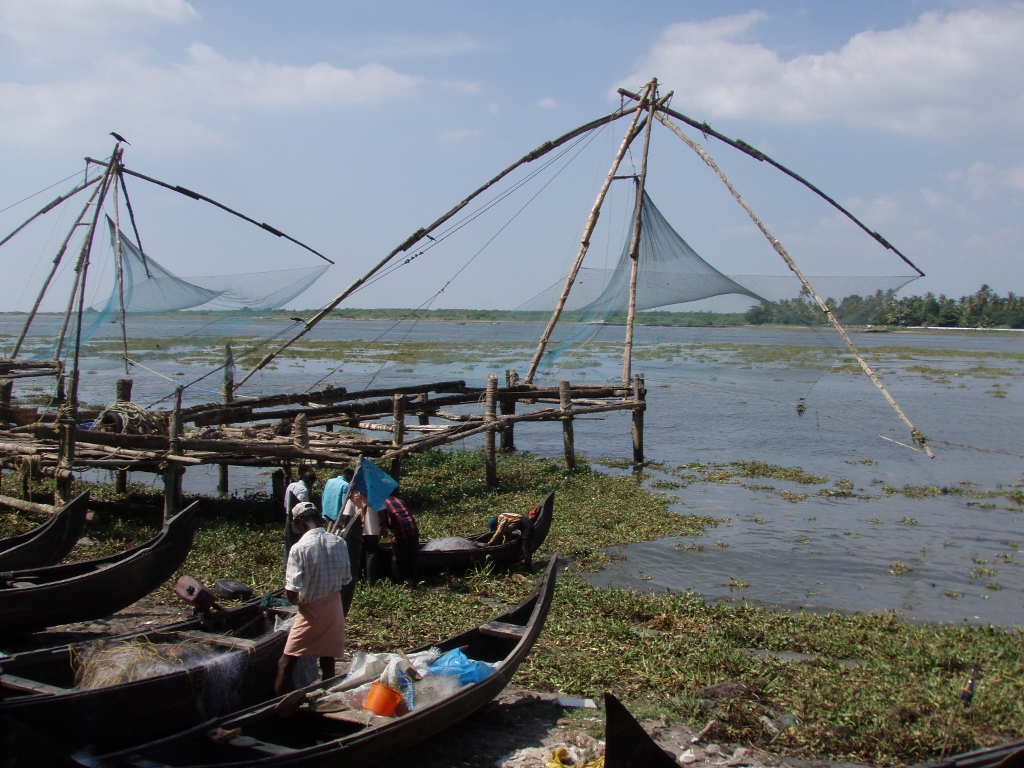 Chinese Fishing Nets
Chinese Fishing Nets
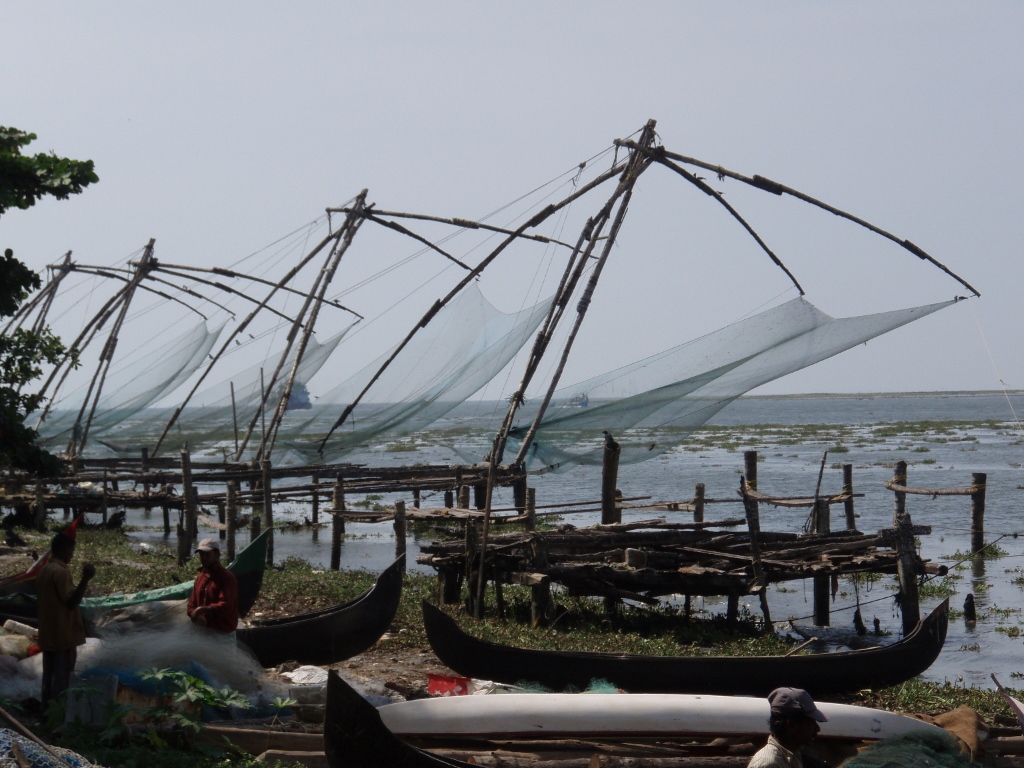 Chinese Fishing Nets
Chinese Fishing Nets
As we watched these nets, we found it fascinating how quickly the water moved which could be seen by the plants growing on its surface. This was obviously the question of the tides. In that section there is practically a strait that connects the Arabian Sea and the large lagoon of a completely irregular shape which is in fact a part of the whole water system that I have mentioned above.
While walking around Kochi we also did some shopping of different small items and souvenirs, as an addition to what we had already bought. Everywhere around India it is possible to see countless colourful trinkets and items made of textile that seem cute and exotic. Since we were in a way killing the time here this morning, we thought it was a good idea to buy some gifts as well.
We had already organised a short trip for the afternoon going on an excursion along the waterways around Kochi. It was nothing spectacular, but it was not bad either. It involved a very leisurely boat ride, before and after which we had some more of the completely mad drives along Indian roads. I realised that this was what bothered me the most in India – this crazy traffic and the terrible noise and use of horns. Particularly in comparison to that, this short excursion was a proper tranquiliser.
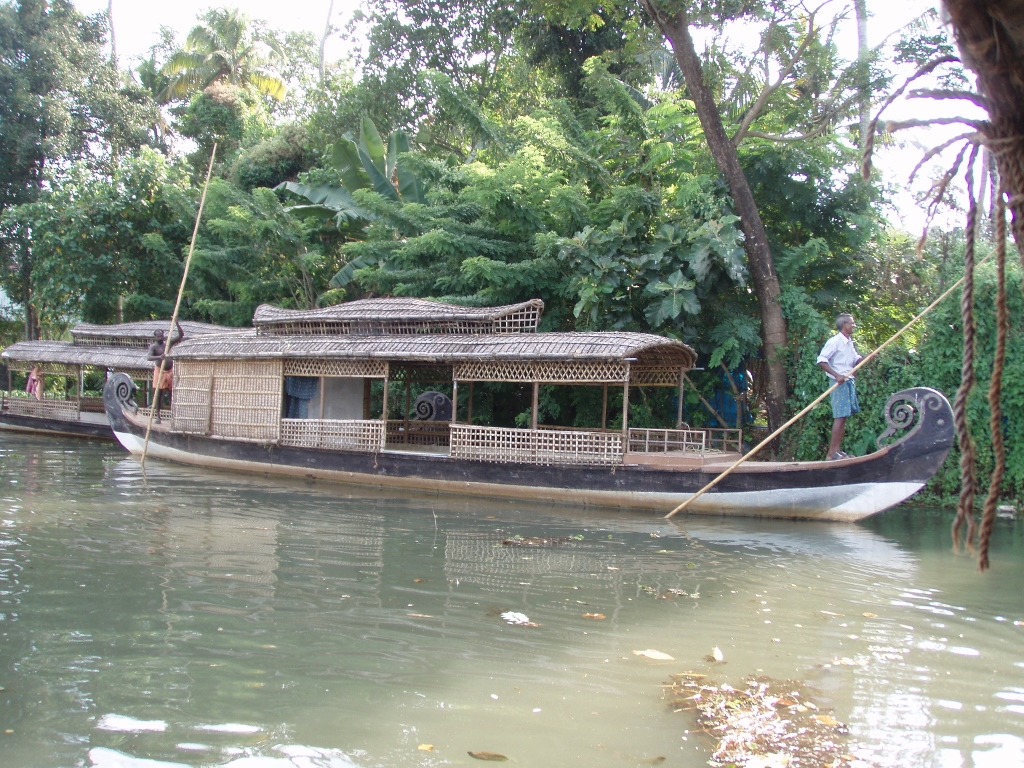 Typical larger boat that is used for taking tourists along the waterways of Kerala
Typical larger boat that is used for taking tourists along the waterways of Kerala
The boat on which we sat on rattan armchairs was moved by human power. There was a local man on the bow and he used a long pole to push the boat against the bottom of the canal. Another man was on the stern, but I did not look at him since the armchairs were arranged facing the bow. The men in this part of the country wear skirts and as we sailed slowly I could not help but wonder if they also wear something else underneath. This has remained as an unanswered eternal question; the same as in the case of the Scotsmen and their kilts.
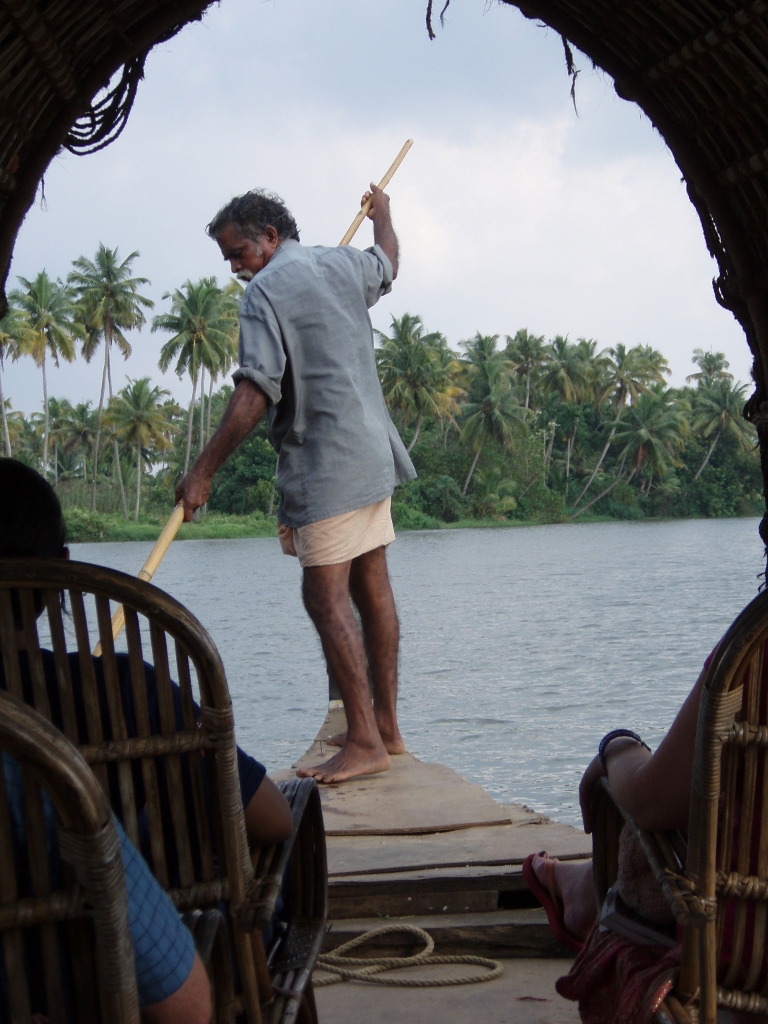 Captain of the boat
Captain of the boat
In that exceptionally slow rhythm we spent three hours sailing along the lagoons, rivers and their branches, and watching the surroundings. People, of course, live around those waterways and thus at some point we saw a mother bathing her child. She did use soap, but both she and the child were in that murky water.
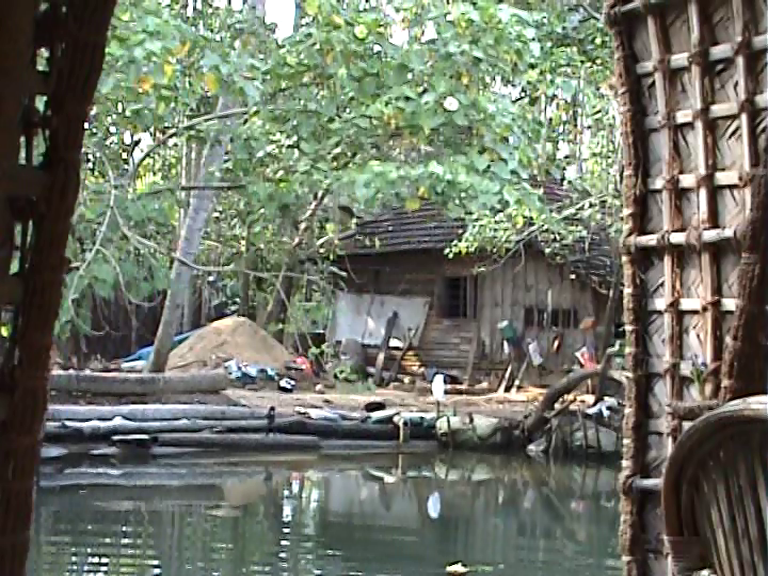 Property by the water
Property by the water
Needless to say, the main means of transportation are boats of all sizes.
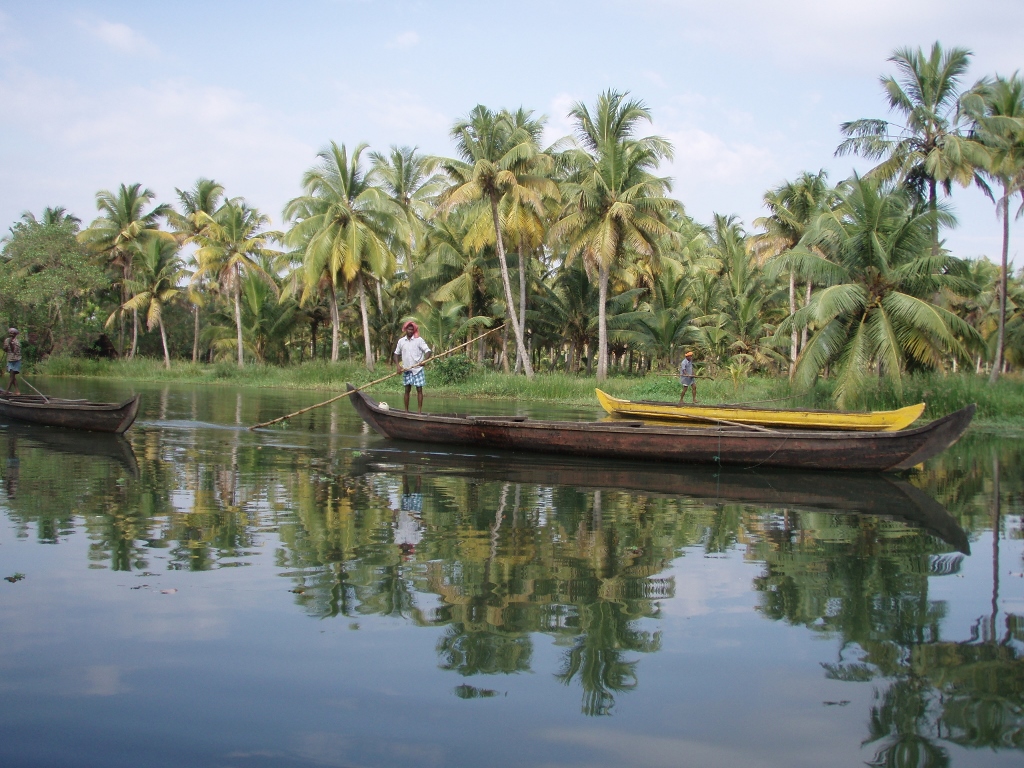 Boats in Kerala
Boats in Kerala
Just as I had supposed earlier when we were by the Chinese Fishing Nets, the moving even of those waters that are inland depends on the sea tides, since everything is interconnected into a massive system of communicating vessels. So, when the low tide starts on the Arabian Sea, the water from the interior heads in that direction. And vice versa, when there is the high tide, then the water moves in the opposite direction, from the sea towards the inland, i.e., it goes back to the rivers and their branches. Hence the name – backwaters. For this reason the water in this system is brackish.
At one point, in order to disembark onto the dry land, we first entered a narrow canal and there they drew our attention to the common water hyacinth (Eichhornia crassipes). This highly invasive species originates in South America. Since it is not known that there has ever been anybody who intentionally transferred the species around the world, it is believed that the plant has spread on its own by attaching itself to the ships while they were in South America and thus it propagated later when those ships went to some other continent.
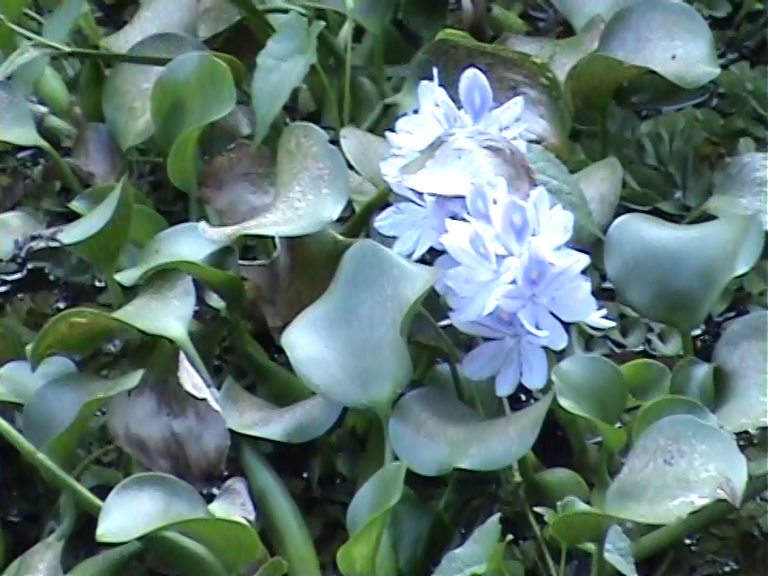 Common water hyacinth
Common water hyacinth
So, there we got out onto the dry land in order to visit a local village so to speak, but the most interesting thing there was when they showed us how they made ropes from fibres obtained from the shell of the coconut. Coconut palms grow here in abundance and the local population has found the ways to use to the maximum everything the palm has to offer.
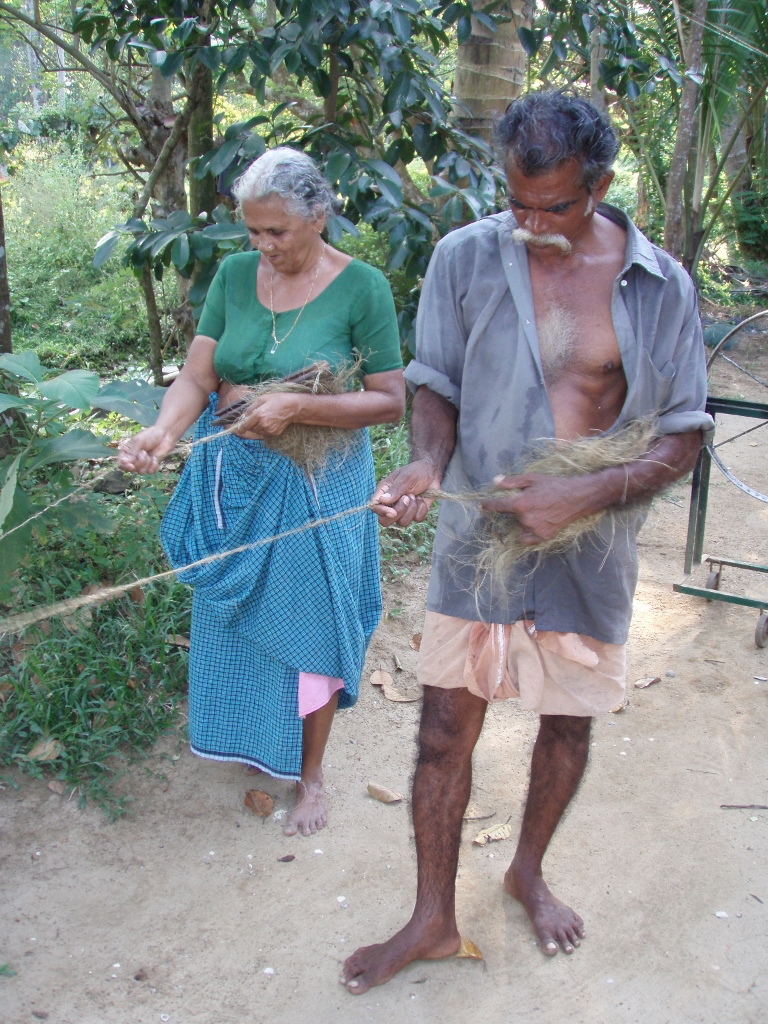 Spinning of coconut fibres into a rope
Spinning of coconut fibres into a rope
While we were spending our time here, we nibbled on the banana and yuca crisps we had bought back in Kochi. We both agreed they were quite tasty.
After this dry land break, we all returned to the boat and continued at the same leisurely pace to move along the backwaters. While sailing in this fashion, we were overtaken by several smaller boats rowed by men and women; the women were always sitting in the front and the men in the back.
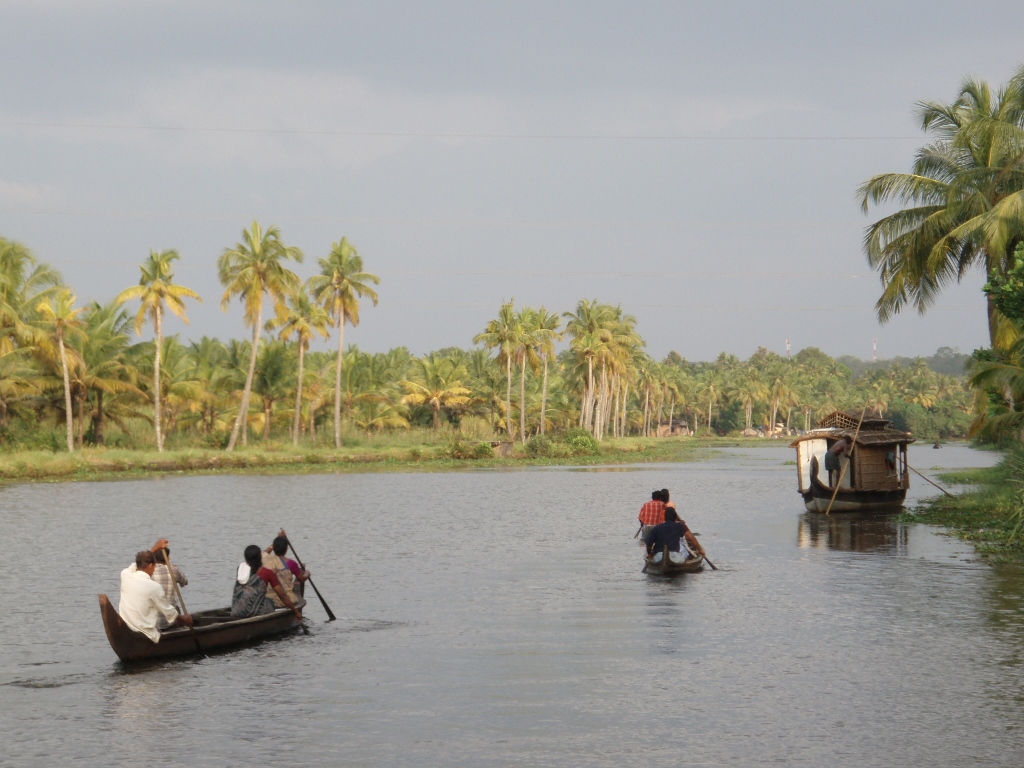 Family transportation along the Kerala backwaters
Family transportation along the Kerala backwaters
Bigger boats like the one we were on were no exception and although their size seemed good for smaller groups of visitors, it did seem eventually that these boats were also used even for entirely local needs.
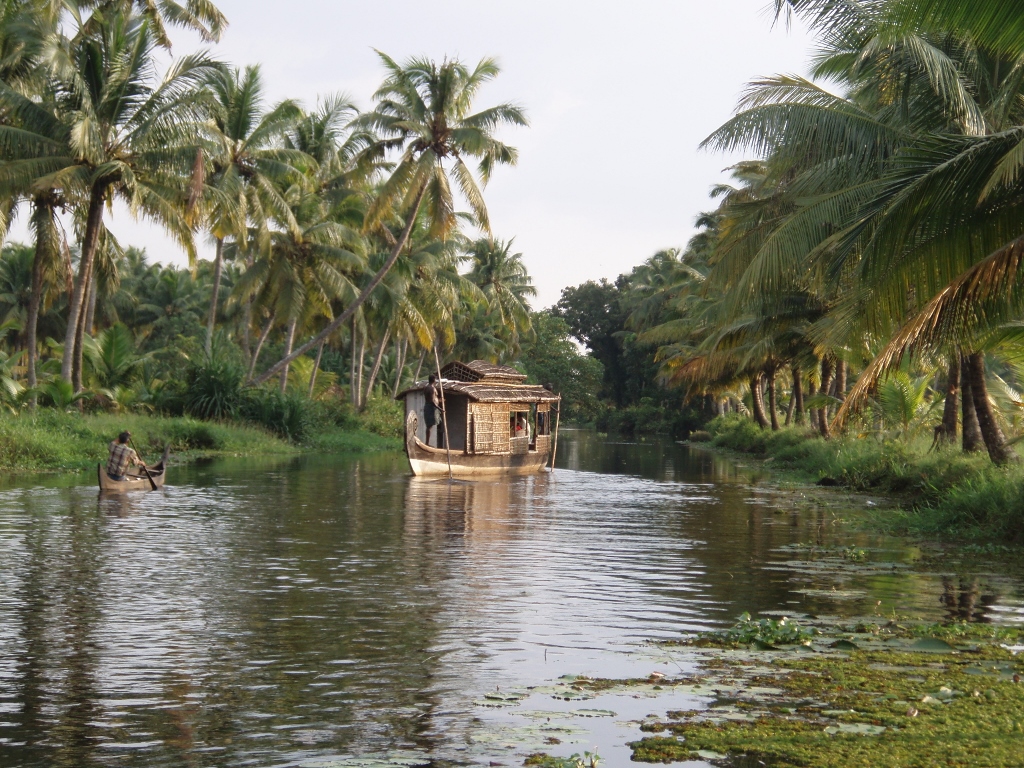 Different vessels on the Kerala backwaters
Different vessels on the Kerala backwaters
During the day Sneža and I agreed that we should go for a nice dinner in the evening. And we did. We got recommendation for a restaurant and there we chose a special offer for the evening – the Sea Platter. It included squids in wonderful sauce, prawns, fish “steak”, big shrimps, crabs and a small lobster. Even for the starter we got some shrimps. Is there any need to emphasise that we enjoyed it thoroughly?
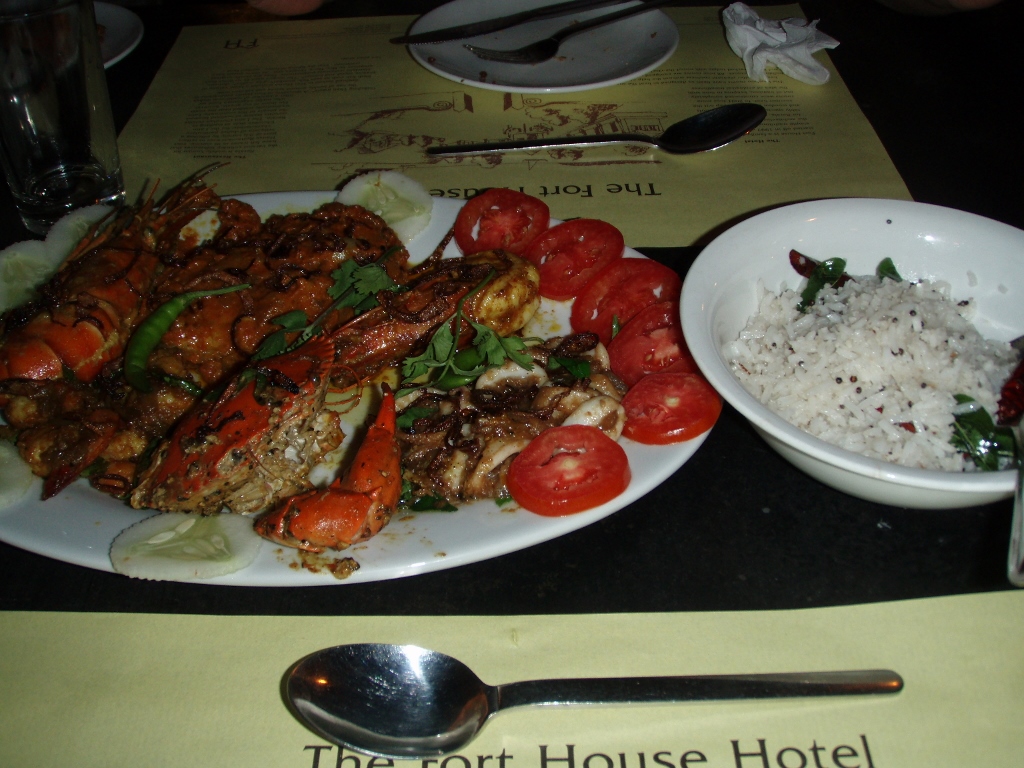 Dinner in Kochi
Dinner in Kochi
Still, before this fabulous dinner we stopped by David’s office (brother of the owner of the hotel we were staying at) who also owned a hotel, in addition to which he was well versed about tourism and organisation of excursions and trips. We had already realised we could not arrange an excursion to see nature, a nature reserve or a tea plantation, as we would like to, so we had opted for that afternoon’s trip along the lagoons. Here at David’s we organised practically the same thing for the next day, but it was to take longer and to replace the transfer farther south by road. The agreement was that a taxi should pick us up in the morning and take us to Alappuzha where we would get on a boat that would take eight hours to get to Kollam. These are all towns in the federal state of Kerala.